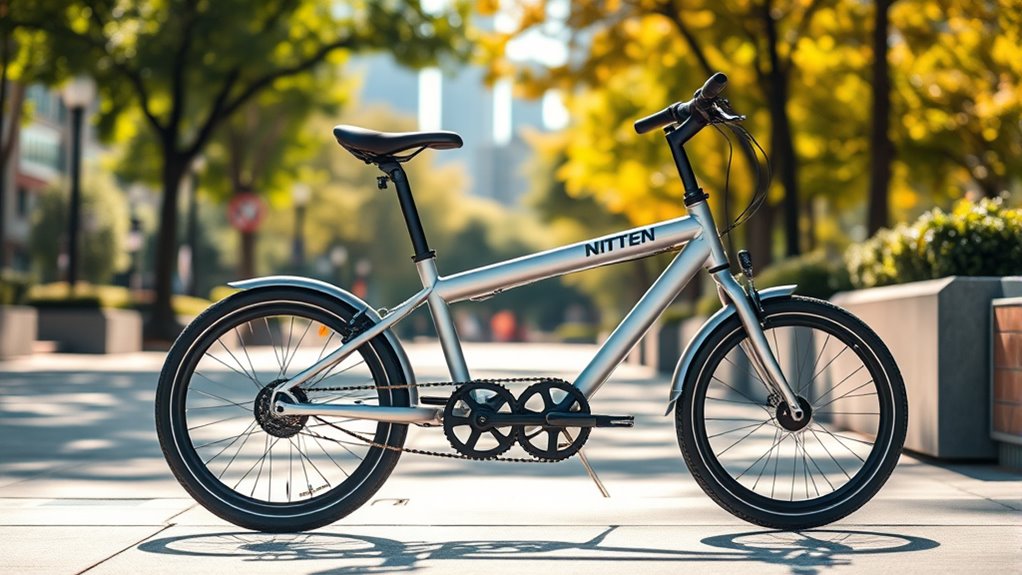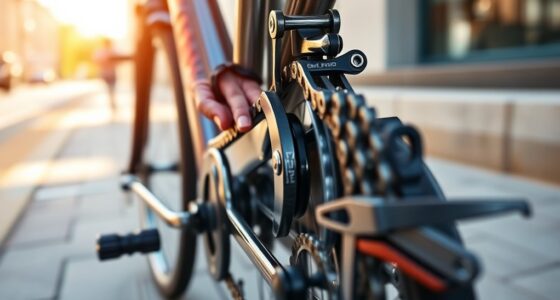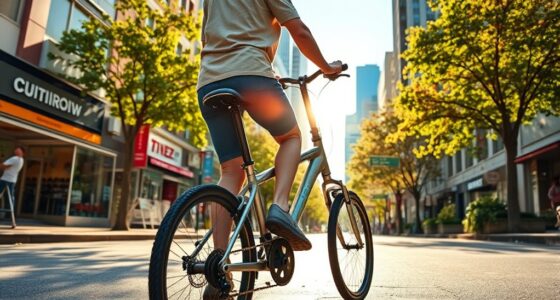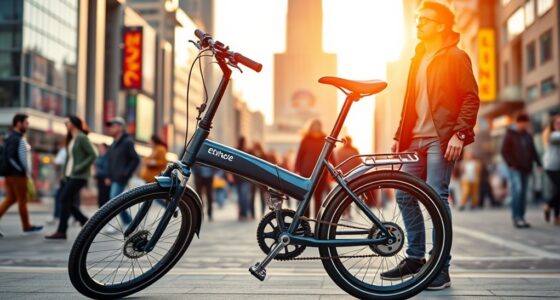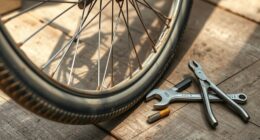To choose the right folding bike, consider your riding style, terrain, and how portable you need it to be. Decide if you want quick, tool-free folding mechanisms and the right wheel size for your typical routes. Think about frame material for durability and weight, and choose features that match your budget—whether basic or premium. For personalized tips and finding the best fit, explore further, and you’ll get the details to make an informed decision.
Key Takeaways
- Assess your riding style, terrain, and daily routine to determine the ideal bike type and features.
- Choose a folding mechanism that offers quick, tool-free folding for convenience and portability.
- Select wheel size and frame material that balance ride comfort, weight, and durability for your needs.
- Review key features like gear options, brakes, and tire pressure to enhance riding safety and efficiency.
- Set a budget and prioritize essential features to find a folding bike that offers the best value for your requirements.
Determining Your Riding Style and Usage Needs
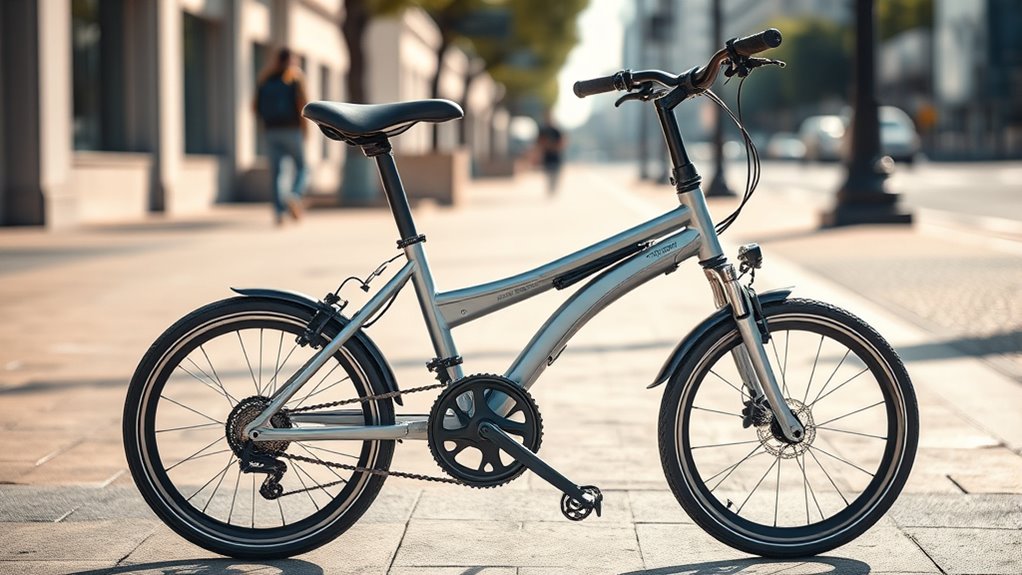
To choose the right folding bike, you first need to understand your riding style and how you’ll use it daily. Your riding style will influence the type of bike best suited for you, whether it’s short urban trips, longer commutes, or off-road adventures. Think about your usage needs—do you prioritize speed, portability, or versatility? Consider the terrain you’ll mostly encounter: flat city streets, hilly areas, or rough paths. If you mostly ride on smooth urban roads, a lightweight, compact model may suffice. For hilly terrain or uneven surfaces, look for bikes with appropriate wheel sizes and suspension features. Clarifying your riding style and terrain helps you choose a folding bike that matches your daily routine and ensures a comfortable, efficient ride.
Evaluating Folding Mechanisms and Portability
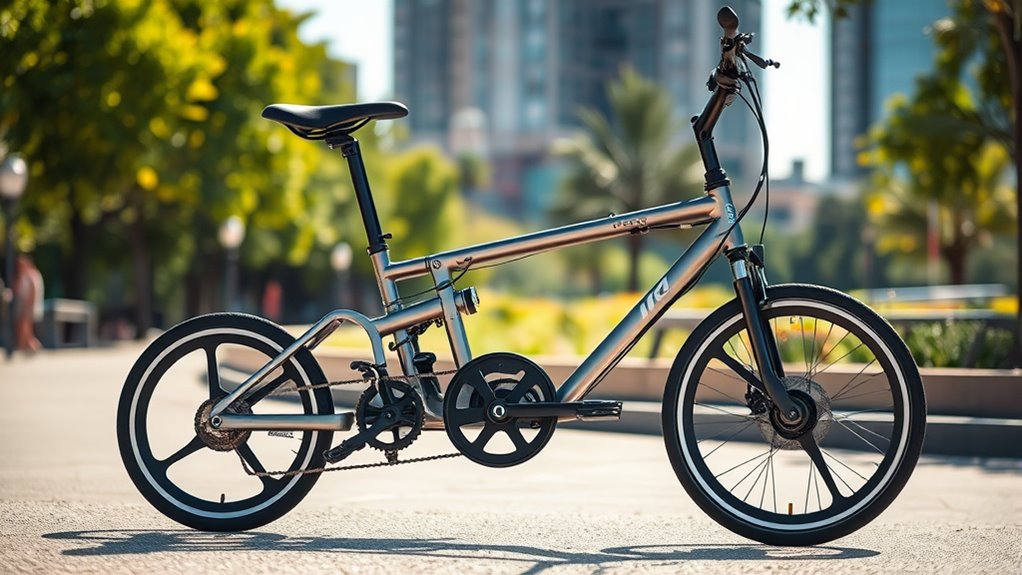
When choosing a folding bike, understanding the different folding mechanisms is essential because they directly affect how compact and easy to carry the bike becomes. Folding mechanisms like mid-hinge, triangle fold, and swivel fold influence the bike’s folded size and convenience. Mid-fold bikes, such as Dahon, fold quickly with a single horizontal move, offering excellent portability for daily use. Triangle fold bikes, like Bike Friday, fold vertically, often creating a smaller, more manageable package for tight storage spaces. The speed of folding varies from under 10 seconds to over a minute, depending on the mechanism and design complexity. Selecting a fold mechanism with minimal steps and tools makes setup and packing faster, greatly enhancing practicality for commuting or travel. Additionally, projector technology advancements can influence how you plan your space, whether for a home cinema or portable setup.
Selecting the Appropriate Wheel Size and Frame Material
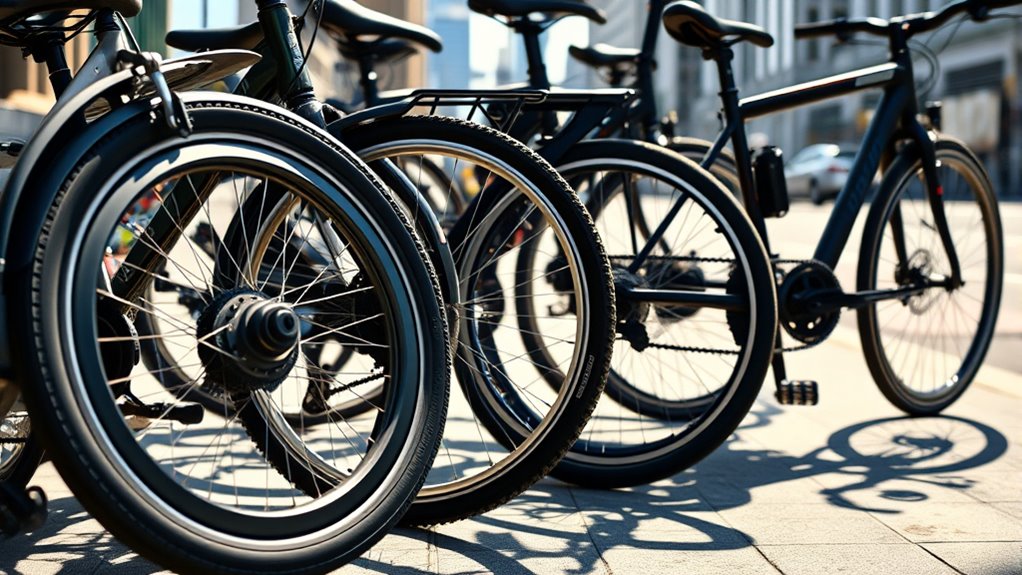
Choosing the right wheel size and frame material can substantially impact your folding bike’s performance and convenience. Smaller wheel sizes, like 16 or 20 inches, boost portability and maneuverability, perfect for steering through tight urban spaces. Larger wheels, such as 26 inches, provide greater stability, comfort, and better handling on varied terrains and longer rides. When it comes to frame material, options like aluminum offer a lightweight, durable, and corrosion-resistant choice, enhancing portability without sacrificing strength. Steel frames are heavier but durable, while carbon fiber frames are ultra-light and ideal if weight savings are your priority—though they tend to be pricier and less durable. Your riding style, terrain, portability needs, and budget should guide your decision on wheel size and frame material. Additionally, choosing high-quality oils for maintenance can help preserve your bike’s components and extend its lifespan. Using appropriate lubricants ensures smoother operation and reduces wear on moving parts. Incorporating spiritual decor elements or calming aesthetics can also enhance your riding experience by creating a more mindful and serene environment. For optimal performance, considering the specific tuning options available for your bike model can ensure it meets your riding needs more precisely. Regularly inspecting your bike and using appropriate lubricants can further improve its longevity and riding quality.
Considering Key Features and Specifications
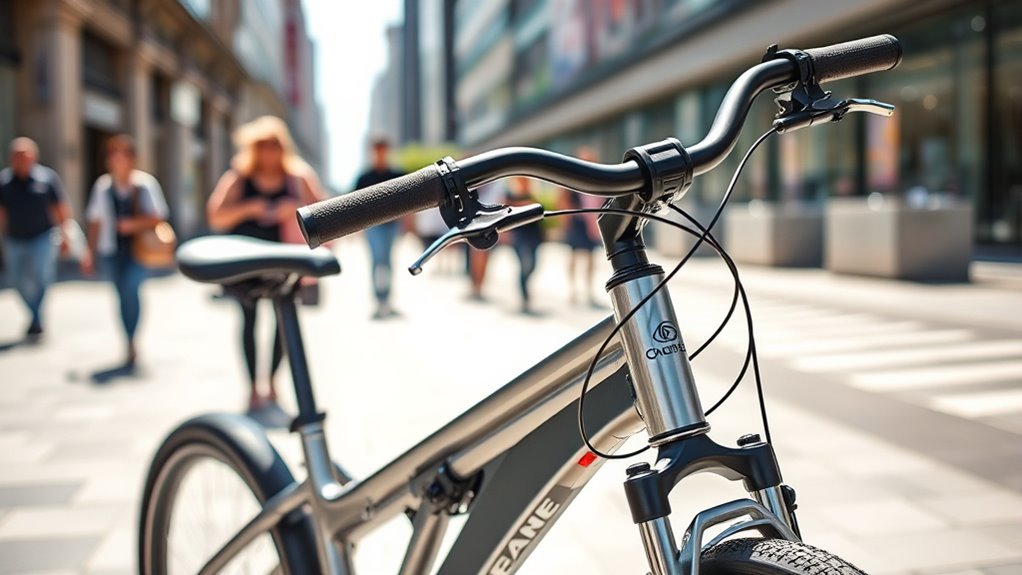
Evaluating the key features and specifications of a folding bike helps guarantee it meets your riding needs and fits your lifestyle. Focus on the folding mechanism—ensure it operates quickly, without tools, and folds to a manageable size for storage or transit. Wheel size impacts portability and ride quality: smaller wheels (16-20 inches) boost maneuverability, while larger wheels (26 inches) provide comfort on varied terrain. Frame materials like aluminum or alloy balance lightweight design with durability, making the bike easier to carry and long-lasting. Review specifications such as gear options, brake types, and components to align with your riding style. Consider the following:
| Feature | Consideration |
|---|---|
| Folding Mechanism | Quick, tool-free folding |
| Wheel Size | Portability vs. ride comfort |
| Frame Materials | Lightweight and durable |
| Gear Options | Number of speeds for terrain versatility |
| Brakes | Reliable stopping power |
Additionally, understanding the tire pressure requirements can improve your riding experience by optimizing traction and comfort.
Balancing Budget With Desired Features
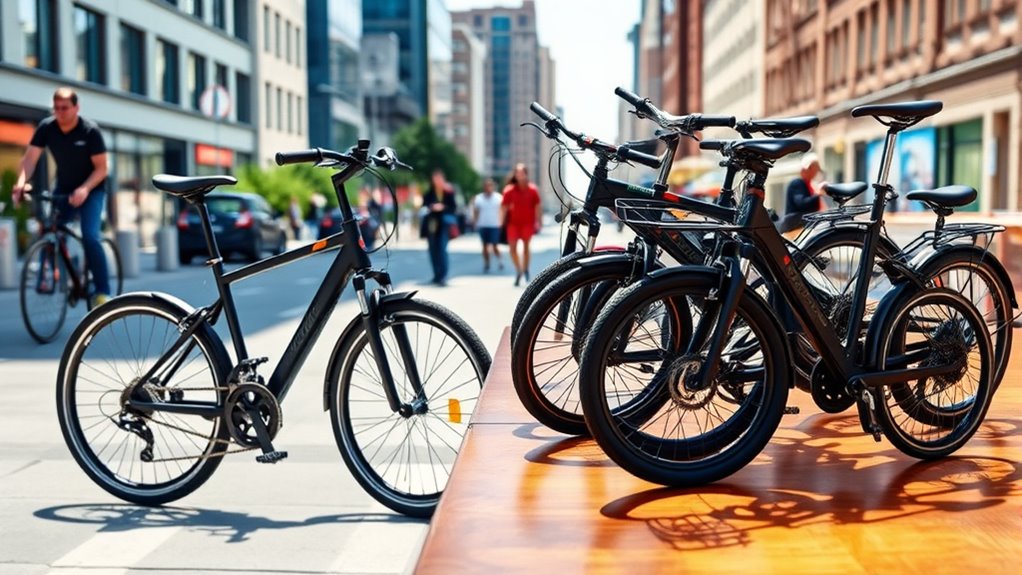
Balancing your budget with the features you want requires careful consideration of what each price point offers. Budget-friendly bikes often use steel or basic aluminum frames, offering durability but fewer features like advanced gears or lightweight construction. These models may impact performance and longevity but are more affordable. Mid-range bikes strike a good balance, providing reliable brakes, decent gear ranges, and easy foldability without breaking the bank. Higher-priced models feature premium materials, lighter weights, and advanced gear options, enhancing ride quality and durability. Features like electric assist, full-size wheels, or cargo capacity considerably increase the price, so prioritize those that fit your specific needs and budget. Setting a clear budget helps you find the best combination of features without overspending. Additionally, understanding the best anime movies and animated films that touch hearts can offer inspiration for your leisure time, complementing your active lifestyle with enjoyable entertainment. Exploring the comparative advantage principle can help you understand how to optimize your investment in a folding bike by focusing on features that provide the greatest benefit relative to their cost. Moreover, considering the design and materials of the bike can make a significant difference in durability and comfort, ensuring your choice aligns with your riding habits and preferences. Being aware of the IRA investment strategy and its tax implications can also help you plan your finances effectively, ensuring you can afford the bike that best meets your needs.
Frequently Asked Questions
How Do I Choose a Folding Bike?
When choosing a folding bike, start by thinking about what you’ll mainly use it for—commuting, leisure, or cargo. Pick a bike with a folding mechanism that’s easy to use and quick to fold. Consider wheel size for portability or comfort, and choose a frame material that matches your daily riding needs. Finally, set a budget to find a model that offers the best features and durability within your price range.
How Do I Find a Good Folding Bike?
Finding a good folding bike is like searching for a trusty sidekick—reliable and ready when you need it. Start by checking its quick-folding mechanism—can you do it in under 10 seconds? Make sure the wheel size matches your riding style, and opt for a lightweight frame for easy carrying. Don’t forget safety features like reliable brakes and gears. Set your budget and choose a model that balances quality with affordability.
How Do I Know What Size Folding Bike to Get?
You determine the right size by considering your typical riding terrain and storage space. If you ride mainly in the city and need portability, go for a bike with smaller wheels like 16 or 20 inches, which fold compactly. For longer rides or varied terrain, larger wheels like 26 inches offer a smoother, more stable experience. Also, make sure the bike fits your height with adjustable seat posts and handlebars.
What Are the Disadvantages of a Foldable Bike?
You should consider that foldable bikes can be heavier due to their hinges and mechanisms, making them harder to carry long distances. The folding process may be slow or complicated, which isn’t ideal for quick stops. Smaller wheels can reduce comfort and stability on rough terrain. They often have limited gear options and lower performance parts, and high-quality models tend to cost more. Keep these disadvantages in mind when choosing a foldable bike.
Conclusion
So, after all that, choosing the perfect folding bike might feel like a puzzle. But don’t worry—you’ll probably end up with a bike that checks all your boxes, even if it’s not the fanciest or cheapest. Irony’s on your side: the more you try to find the ‘perfect’ ride, the more you’ll realize it’s about finding what works best for you. Happy folding—your new bike’s waiting to make every commute a little more fun!
